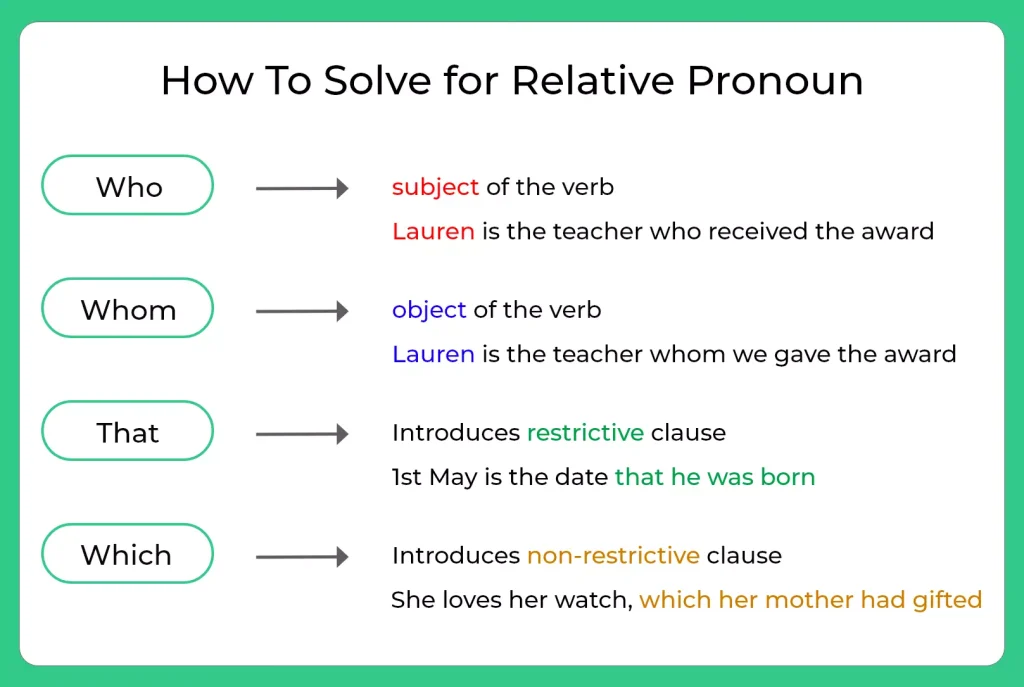Verbal Menu
- Basic Grammar
- Speech and Voices
- Tenses
- Articles
- Tenses and Articles
- Idioms and Phrases
- Subject Verb Agreement
- Prepositions and Conjunction
- Selecting Words
- Relative Pronoun
- Sentence Completion
- Sentence Ordering
- Contextual Vocabulary
- Jumbled Sentence
- Sentence Formation
- Error Identification
- Sentence Improvement and Construction
- Cloze Test
- Fill in the blanks
- Paragraph Ordering
- Para Jumbles
- Synonyms and Antonyms
- Synonyms
- Antonyms
- Reading Comprehension
- Get Off-campus Drive Updates
- Get Hiring Updates
- Contact US
PREPINSTA PRIME
How To Solve Relative Pronoun Questions Quickly
How to Solve Relative Pronoun
Understanding How to Solve Relative Pronoun is not very difficult. Once you get the idea of the different types of Relative Pronoun and their usage, the questions becomes easy. But before that let’s take a look at the relative pronouns and bush up our knowledge.

How to Solve Relative Pronoun Quickly
Before heading towards how to solve relative pronoun, we need to understand how we can use these relative pronoun in a sentence. See the table below to take a look at its usage and an example.
The list if Relative Pronouns are:
- Who
- Whom
- That
- Which
- What
- Whose
For Example:
- The salesman who looked into my bills has been working in the store for five year
- Lauren will be the actress whom we have chosen for the lead role
- Riya handed over me the dress that she had won for her birthday
- Jess went on to wear a fur coat, which has velvet buttons, for the night party.
- I can never decide what to eat in a party
- The farmer reported a case whose cows were stolen from the shed

Relative Pronoun Usage
| Relative Pronoun | Usage | Example |
|---|---|---|
| Who |
|
It was my friend who dropped off the gifts |
| Whom |
|
The teacher whom we greeted was appointed by the supervisor |
| That |
|
The black shoe that I bought for the trip was stolen |
| Which |
|
The cardboard boxes, which were folded by me, are kept in the store |
| What |
|
I might not know what to say, but i definitely know how to say. |
| Whose |
|
The man whose daughter had gone missing has left us a message |
Some More Rules for How to Solve Relative Pronoun
Defining vs. Non-Defining Relative Clauses
A sentence has two parts which can be put together to form a sentence. They are divided into:
- Defining / Restrictive Clause
- Non-defining / Non-Restrictive Clause
Defining Clause
Defining Clause is the one that adds additional information in a sentence which is essential. This type of information cannot be removed from the sentence or else it can leave a sentence incomplete or meaningless. This sentence also doesn’t require any punctuation.
This is the man that was bitten by a dog.
These are the students who were involved in malpractice during examination
These are two sentences which require the additional information. If any of the sentences had the second clause missing, the sentences would be let incomplete.
For example:
These are the students OR This is the man.
They are incomplete sentences.
Non-Defining Clauses
Non-Defining Clause is the part of a sentence that gives an additional information about the noun but is however not essential to give meaning to a sentence. Even if we remove the clause, the sentence would not be affected. A non-defining clause is essentially separated with a comma to reflect that you can remove it from the sentence.
For Example:
This bed, which is 50 years old, belonged to my grand father.
The painting, which is hung on the wall, is worth million dollars
In the sentences above, the phrase or clause that is within the punctuation can be eliminated and the sentence would still have the same meaning.
This bed belonged to my grand father.
The painting is worth million dollars
How To Solve Relative Pronouns
There are several relative pronouns which we generally confuse between. Let’s read some of them and clear out our confusion.
When V/S Where
Sometime WHEN and WHERE can also be used as relative pronoun.
When is used to introduce a noun that describes the time of occurrence
Where is used to introduce a noun with respect to a place, and where refers to a place.
For Example:
My mother remembers the time when she was the best athlete in her town
My father couldn’t recall where he had kept his glasses
Who V/S That
The most common confusin is between Who and That. These two words are generally misplaced and used in alternate senses.
Who is placed in a sentence which describes the person as a relative pronoun,
That is used to describe an object or non-human things.
We adore the children who obey their parents
I am afraid of the dogs who are large in size and scary to look at
Which V/S That
Another most common error occurs while placing that and which in a sentence.
We use Which to describe objects and non-living things that introduces a dependent clause and relates with the non-restictive clause. This non-restrictive clause is non-essential to the defining/dependent clause.
We use That on the other hand to provide additional information but this information is a restrictive clause and is essential to give information about the noun.
For Example:
The goat, which is quite old, went inside the shed
The goat that has only one hon went inside the shed.
Whose and Whom
Whose is used to replace Who when possession of the noun is in reference.
Whom is used in a sentence as the object of the verb or preposition.
For Example:
This is Riya, Whose purse has gone missing.
This is Riya whom you met in the party yesterday
Prime Course Trailer
Related Banners
Get PrepInsta Prime & get Access to all 200+ courses offered by PrepInsta in One Subscription
Also Check Out
Also Check:
- Basic Grammar – Questions | Rules | How to Solve Quickly | Tricks & Shortcuts
- Speech and Voices – Questions | Rules | How to Solve Quickly | Tricks & Shortcuts
- Tenses – Questions | Rules | How to Solve Quickly | Tricks & Shortcuts
- Tenses and Articles – Questions | Rules | How to Solve Quickly | Tricks & Shortcuts
- Idioms and Phrases – Questions | Rules | How to Solve Quickly | Tricks & Shortcuts
- Subject Verb Agreement – Questions | Rules | How to Solve Quickly | Tricks & Shortcuts
- Prepositions and Conjunction – Questions | Rules | How to Solve Quickly | Tricks & Shortcuts
- Selecting Words – Questions | Rules | How to Solve Quickly | Tricks & Shortcuts
- Relative Pronoun – Questions | Rules | How to Solve Quickly | Tricks & Shortcuts
- Sentence Completion- Questions | Rules | How to Solve Quickly | Tricks & Shortcuts
- Basic Grammar
Questions
Rules
How to Solve Quickly
Tricks & Shortcuts - Speech and Voices
Questions
Rules
How to Solve Quickly
Tricks & Shortcuts - Tenses
Questions
Rules
How to Solve Quickly
Tricks & Shortcuts - Tenses and Articles
Questions
Rules
How to Solve Quickly
Tricks & Shortcuts - Idioms and Phrases
Questions
Rules
How to Solve Quickly
Tricks & Shortcuts - Subject Verb Agreement
Questions
Rules
How to Solve Quickly
Tricks & Shortcuts - Prepositions and Conjunction
Questions
Rules
How to Solve Quickly
Tricks & Shortcuts - Selecting Words
Questions
Rules
How to Solve Quickly
Tricks & Shortcuts - Relative Pronoun
Questions
Rules
How to Solve Quickly
Tricks & Shortcuts - Sentence Completion
Questions
Rules
How to Solve Quickly
Tricks & Shortcuts
Get over 200+ course One Subscription
Courses like AI/ML, Cloud Computing, Ethical Hacking, C, C++, Java, Python, DSA (All Languages), Competitive Coding (All Languages), TCS, Infosys, Wipro, Amazon, DBMS, SQL and others

 Apply For Jobs
Apply For Jobs Get Hiring Updates
Get Hiring Updates




Login/Signup to comment